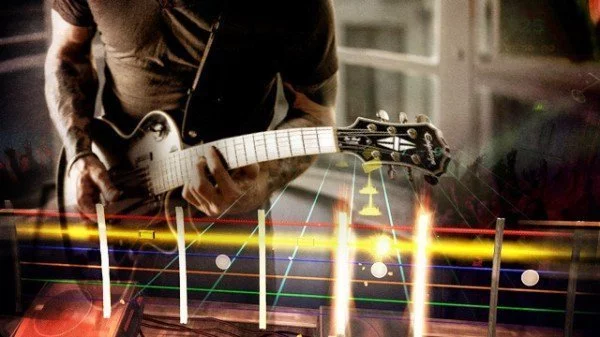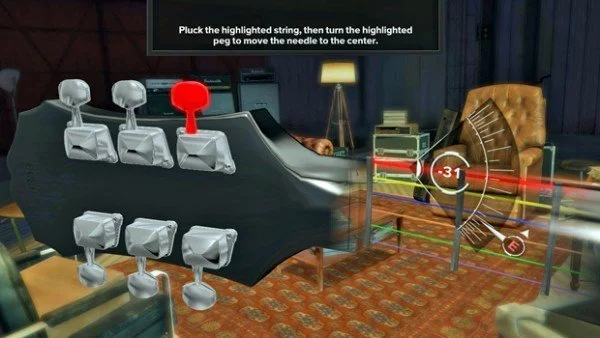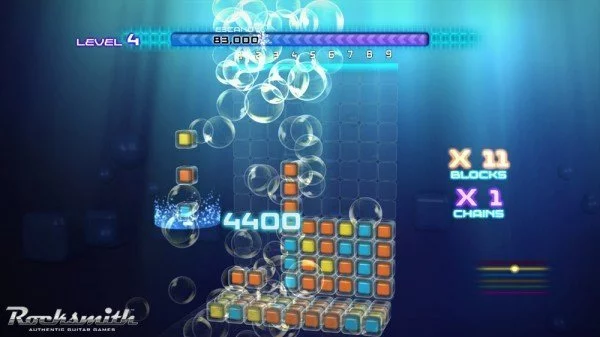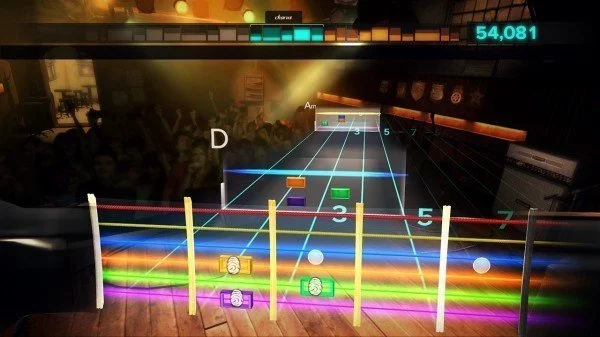When I first heard that we were going to be reviewing Rocksmith, I jumped at the opportunity to be the one to do it. Long had I wanted to be a guitar virtuoso like my friends and brother. I wanted to be the guy who could pull out an acoustic guitar at a party, strum out a few songs and woo all the girls. I wanted to be that cool, edgy rock star. After spending the better of two weeks with Rocksmith I can safely say that I am none of those things, but I can say that I’m on my way.
Ok, “on my way” may be a bit strong, but I am definitely improving and have a clear idea of the basics of guitar playing. Rocksmith isn’t your typical guitar-based video game. There are no plastic peripherals and no coloured buttons. You play a real guitar. Thanks to some amazing tech developed by GameTank for the unreleased Guitar Rising project, you simply plug the jack end of the bundled lead into your guitar and the USB end into your console or PC and you are ready to rock. Rocksmith recommends external speakers through a home theatre system for the best sound, and from the hours I spent with it, anything less than a decent system would be doing the game a disservice.
Starting out as a guitar noob, I found the game eased me into the experience really gently. It started out by asking me to tune and explained everything as it went. For someone like me — who’s been around guitars and bands most of my life — I found it a little patronising, but for someone without any guitar knowledge at all it would be essential. I would have loved a “skip” button, though. The first song fired up was “(I Can’t Get No) Satisfaction” by The Rolling Stones. Prior to starting the song, the game gave me a brief tutorial on strumming single notes, then jumped straight in. Even at this very easy stage, I was quickly overwhelmed. The game — responding to the mass of notes I was missing — changed the difficulty on the fly, reducing the number of notes, fret and string changes. As I got better at this reduced difficulty, Rocksmith again dynamically shifted difficulty and introduced additional strings, frets and more frequent notes. This really blew me away. At first I was getting frustrated that I was so terrible at playing that guitar, but as the game ebbed and flowed the difficulty with my current skill level I was able to really feel a sense of achievement and accomplishment during some of the songs.
Aside from the playing of the songs, Rocksmith includes tutorials for all of the basic guitar techniques. Strumming, hammer ons and pull offs, scales, palm muting… you name it. As you learn the techniques, new songs are introduced which make use of your new skills. It keeps you on your toes for the duration and pushes you to get through each song to find out what is in store for you next.
Now as I mentioned before, I am a guitar playing noob, so I thought it best to get the opinion of a friend. Chris Laurie is an experienced bass and guitar player, and has recently completed study in audio engineering and sound design.
Stevivor: So Chris, tell us your initial impressions of Rocksmith.
Chris: As I’m an experienced bass player perspective I chose to start out with the bass. I found the introduction tedious and was constantly thinking “Well, Duh” as the game explained basics of guitar/bass playing. Upon reflection I can see why this had been done. Novice gamers that haven’t touched a real guitar before will need this kind of hand holding at first, but once they develop their confidence, they’re gonna be in for a treat.
Stevivor: What did you think of the audio quality of the game? As both an experienced musician and an audio engineer how did Rocksmith compare to a proper amp and speaker stack?
Chris: I was very impressed with the sonic tone of the bass and the sounds. It’s a real testament to the technology and design of the game that you are able to plug your guitar into your PS3, play though your TV and have such a wide range of sounds and tones, essentially replicating what you can do with a speaker stack worth thousands. I also loved the soundtrack. The first song “Where is my Mind” by The Pixies was a perfect song begin with on the bass for beginners and pro’s alike. I’d expect a load of future DLC songs in the future as there is the potential to grow tired of the songs on the disc or master them to the point of boredom.
Stevivor: So how would you rate the interface and the ability for Rocksmith to actually teach people to play guitar?
Chris: I was totally blown away when the complexity of the track increased mid song. It was great validation that I could actually play. I absolutely love the mature layout when compared to other “guitar” games like Guitar Hero. Cleaner tones, better songs and no over-the-top cartoon characters with magic powers. The fact that the guitars looked and sounded authentic coupled with the ability to use versions of real world amps and pedals is phenomenal. Manipulating your own sound was a lot of fun and I spent many hours spent playing with the amp selection. That being said, it did take some time to explore and get my head around the menu and interface. Having played some of the songs before, I was thrown when the game had different fingering positions. Re-learning these songs was a little frustrating but in the end good practice.
Stevivor: Aside from the main game, how did you find the overall package?
Chris: Well after I’d played the “quest mode” for a few hours I’d reached Rank 4 “Local Headliner” so I decided to explore the Arcade mini-games. I found the duck shooter to be a little odd. In that mode you have to hit the note on the correct fret and string to shoot down ducks as they fly away. It was fun, but not really a helpful learning exercise. The scale runner was really awesome! If only I had this when I was trying to learn my scales! It really made doing scales fun and actually helped to improved my dexterity.
Aside from the mini-games, when it came to actually playing and setting up the game it appeared that Ubisoft had thought of everything. For some players the standard display (with the E string on the top) is frustrating as they may have learnt using tabs. However, Rocksmith caters to even these players allowing you to convert the display to “TAB” format. The fact that the developer went to this level of detail is really impressive. If only half the games ever released got this much attention.
Overall, I am just blown away by the game. I can see this helping to usher in a new generation of guitarists. Kids shredding away on the heaviest of solos but, not on a plastic guitar on a real instrument.
Rocksmith is a the first of a new breed of rhythm game and the natural evolution of these games on console. The fact that we are now able to play real instruments and play the actual songs within a video game is a huge step forward. I only hope that the fatigue that set in with gamers after Guitar Hero doesn’t negatively affect the sales of Rocksmith.
While not always perfect, the gigantically steep learning curve and the ease with which you can be discouraged as a newbie to guitar chief among the issues, once you get over the initial hurdle you will find a deep, rich and rewarding game/learning experience. Now if you’ll excuse me, I’m off to learn “In Bloom” by Nirvana.
We owe a big thanks toChris Laurie for his assistance with this review! -Editors
This article may contain affiliate links, meaning we could earn a small commission if you click-through and make a purchase. Stevivor is an independent outlet and our journalism is in no way influenced by any advertiser or commercial initiative.



























